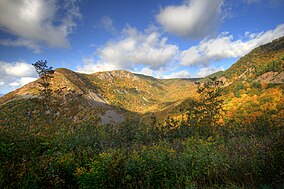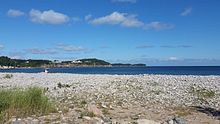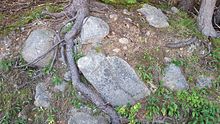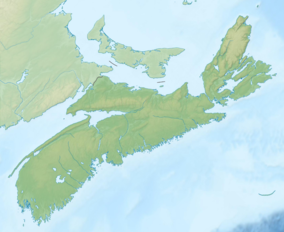Cape Breton Highlands National Park
| Cape Breton Highlands National Park | |
|---|---|
 Autumn colours in the park | |
| Location | Ingonish, Nova Scotia, Canada |
| Coordinates | 46°44′00″N 60°38′30″W / 46.73333°N 60.64167°W |
| Area | 949 km2 (366 sq mi) |
| Established | 1936 |
| Visitors | 333,746[1] (in 2017-18) |
| Governing body | Parks Canada |
| Website | http://www.pc.gc.ca/en/pn-np/ns/cbreton/ |

Cape Breton Highlands National Park is a Canadian
It consists of mountains, valleys, waterfalls, rocky coastlines and the
Rivers in the park include the Chéticamp River and the North Aspy River.
In 2014, Parks Canada started a four-year project with the Unama'ki Institute of Natural Resources, among other partners, to begin regional boreal forest restorations within this park.
Recreation
One-third of the Cabot Trail passing through the park features ocean and mountain views. The park is known for its "steep cliffs and deep river canyons that carve into a forested plateau bordering the Atlantic Ocean".[5]
The park contains 26 marked hiking trails,[6] including the Skyline Trail.
At the western entrance of the park is the
There are five main salt water ocean beaches in the park and two freshwater lakes. The ocean beaches include Ingonish Beach, North Bay Beach, Broad Cove Beach, Black Brook Beach and La Bloc Beach. The two freshwater beaches include Freshwater Lake and Warren Lake. Freshwater Lake and Ingonish Beach are both supervised with a lifeguard during the summer months. There are very strong currents at Black Brook and Ingonish Beach which must be considered when bringing small children to these two beaches.[5]
Wildlife
Birds visible from this park include three species of hawk, two species of owl, northern gannets, kestrel, Bicknell's thrush, and the bald eagle. The first nest records of boreal owl for Nova Scotia were found in the southwestern corner of this park in 2004.[8][9] This park is listed as an Important Bird Area.[10]
Mammals include white-tailed deer, marten, lynx, muskrat, snowshoe hare, beaver, mink, bobcat, river otter, stoat, red fox, raccoon, moose, black bear, skunk, and coyote.[11] The Gaspé shrew, the local name for a smallish variety of the long-tailed shrew, Sorex dispar, can be found on rocky slopes in the park.
Aquatic life visible from this park includes North Atlantic right whales,[12] humpback whales, fin whales, minke whales, sei whales pilot whales, Atlantic white-sided dolphins, harbor seals, harp seals, and grey seals.
Reptiles include garter snake, red belly snake, ring-necked snake, smooth green snake, wood turtle and leatherback sea turtle.
Parks Canada transferred eighteen western moose (nine bulls, nine cows) from Alberta's Elk Island National Park to this national park between 1947 and 1948.[13]
In late October 2009, country folk singer Taylor Mitchell died as a result of her injuries and blood loss due to coyotes attacking her while she was hiking by herself on the Skyline Trail. This incident became the only recorded fatal coyote assault on an adult as well as a Canadian.[14][15]
Geology


Most of the park resides within what is called the
Along the
A Middle to 375 Ma
The Cabot Trail then doglegs to the north, crossing the Wilkie Brook
The Cabot Trail then follows the Grande Anse River westwards, with exposed Horton Group until it reaches the coast at Pleasant Bay. This is the location of the 364 Ma
As the trail loops west to follow the coastline, rocks of the 439 Ma Ordovician-Silurian Jumping Brook Metamorphic Suite are exposed. This suite consists of
Gallery
-
The Cabot Trail viewed from the Skyline Hiking Trail
-
A moose resting in the park
-
Part of the Skyline Hiking Trail
-
Black Brook Beach
-
spyhoppingoff Cape Breton
See also
- National Parks of Canada
- List of National Parks of Canada
- List of parks in Nova Scotia
References
- ^ "National Parks, Park Reserves, and Marine Conservation Areas". Parks Canada Attendance, 2017-18. Parks Canada. Archived from the original on January 4, 2019. Retrieved Jan 31, 2019.
- ^ "Geographical Names of Canada - Cape Breton Highlands National Park of Canada". Government of Canada. Retrieved 16 June 2018.
- ^ "Cape Breton Highlands National Park, Cabot Trail". Archived from the original on 2000-04-13. Retrieved 2011-03-29.
- ^ Finkelstein, Maxwell W. (9 February 2010). "Cape Breton Highlands National Park". The Canadian Encyclopedia. Historica Canada. Archived from the original on 11 January 2018. Retrieved 29 March 2011.
- ^ a b "Cape Breton Highlands National Park". Parks Canada. 24 March 2015. Retrieved 30 March 2014.
- ^ "Cape Breton Highlands National Park". Government of Canada. Retrieved 24 March 2019.
- ^ "Cheticamp - Cape Breton Island - Nova Scotia". Archived from the original on 24 May 2011. Retrieved 29 March 2011.
- S2CID 86525931.
- ^ Lauff, Randolph F. (Oct–Nov 2007). Johnson, D.H.; Van Nieuwenhuyse, D.; Duncan, J.R. (eds.). First nest records of the Boreal Owl Aegolius funereus in Nova Scotia, Canada (PDF). Proc. Fourth World Owl Conf. Project Owl Net. Vol. 97, no. 4. Groningen, The Netherlands: Ardea. pp. 497–502. Retrieved 26 May 2015.
- ^ "IBA Site Listing". www.ibacanada.org. Retrieved 2021-02-03.
- ^ "Eastern coyote - Cape Breton Highlands National Park". 20 November 2018.
- ^ "Saltwire | Halifax".
- ^ "Moose - Cape Breton Highlands National Park". 20 November 2018.
- ^ "Woman airlifted after attack by coyotes in Cape Breton". CTV News. Sydney, Nova Scotia. Canadian Press. 27 October 2009. Retrieved 26 May 2015.
- ^ "Cape Breton coyote attack kills touring folk singer". CTV News. 28 October 2009. Retrieved 19 September 2014.
- ^ ISBN 9781927099438.
- ISBN 0-660-13134-X.
- ^ a b c d e Keppie, J.D. (compiler) (2000). Geological Map of the Province of Nova Scotia, Map ME 2000-1, scale 1:500 000. Nova Scotia Department of Natural Resources, Minerals and Energy Branch.
- ^ Baird, David (1971). Cape Breton Highlands National Park, where the mountains meet the sea, Misc. Report 5. Ottawa: The Geological Survey of Canada, Dept. of Mines and Technical Surveys. pp. 28–32.
- ^ Dawson, William (1891). The Geology of Nova Scotia, New Brunswick, and Prince Edward Island, or Acadian Geology. London: MacMillan and Co. pp. 71, 83.
- ^ Miller, Brent (1997). Geology, Geochronology, and Tectonic Significance of the Blair River Inlier, Northern Cape Breton Island, Nova Scotia. Halifax: Dalhousie University.






